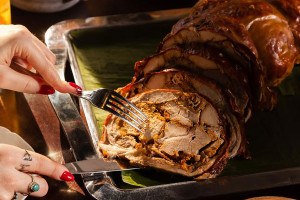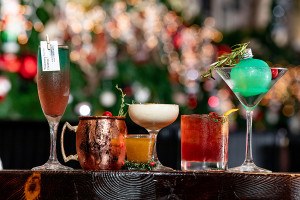Beer: It’s What’s For Breakfast
H.L. Mencken knew how to start the day Photo courtesy wisconsinhistory.org
If you’ve been to enough local beer festival day sessions, you’ve probably been greeted near the door a time or two by what may have struck you as a surprising greeting from Unibroue sales rep Bernard Johnson. “Beer mimosa?” he may have asked, pouring his Blanche de Chambly witbier from a tap then topping it with a few splashes of o.j. before handing it to you. Chances are, you crinkled your nose in perplexion, sipped it curiously then proclaimed all manners of sparkling wine henceforth dead to you.
Once chiefly the domain of Wildwood partiers who passed out wearing T-shirts that read, “Beer, It’s Not Just for Breakfast Anymore,” or “Beer, The Breakfast of Champions,” the beer breakfast has, in our current crafty times, gone mainstream and upscale. There are many refreshing beers that can be mixed with fruit juice (or not) and sipped from a Champagne flute over a summer brunch on the terrace. And what follows are a few tips, styles and examples to get you started on what some refer to as the Redneck Mimosa.
Drinking Beer For Breakfast
- You can replace bubbly with beer in almost any drink.
- Don’t get stuck on OJ. Try blood orange, peach, grapefruit, mango or pineapple juice, or a combination thereof.
- Ice is not recommended, as it dilutes the drink, but these are cocktails that should be drunk chilled.
- Don’t forget to garnish for maximum visual effect.
- Citrusy beers are usually best, as they’ve already got a foundation of fruit flavor.
- Wits/whites/wheats/Weisse beers are often a first choice, as they tend to be fizzy, pale, a touch spicy or peppery and redolent of oranges and coriander. Good ones are Allagash White and Hitachino Nest White Ale. For a traditional German twist, buy a Berliner Weisse and drink it out of a goblet “mit Shuss,” meaning with a shake of grenadine or other flavored syrups.
- Hoppy beers can work, too, primarily if the hops used are of a citrus variety and have a low bittering value. Look for beers brewed with Cascade, Amarillo and Centennial hops like Ommegang Belgian Pale Ale, Peak Organic Summer Ale, and Mikeller Single Hop Cascade IPA.
- Fruit beers can also work well, though think hard about what fruit flavors you’re combining. You don’t want the fruit in your beer to clash with or overpower the fruit in your juice. It’s probably best to just use a touch of juice with these. Solid fruit beers include Blue Point Blueberry Ale, Ithaca Apricot and Dogfish Head Festina Peche. These would be good to also try with flavored syrups or muddled fresh fruit and/or mint, especially the Festina Peche.
Of course, if you’re more partial to the Bloody Mary, you can always fill a cup halfway with light American lager or Mexican lager and fill the rest with bloody mix, then garnish. For a time-tested hangover remedy, crack a raw egg into the mixture. Minus ten points for puking. And for a toasty morning warm-up in the winter, breakfast stouts like Founder’s Breakfast Stout and its elusive Kentucky Breakfast Stout and Canadian Breakfast Stout make a nice substitute for cereal. For those of you who can’t live without your morning jolt of caffeine, coffee porters and stouts are robust and sometimes creamy (especially those brewed with lactose … called milk stouts or porters) and often appeal to those who’d rather eat spent grain than sip a cup of java. Some of our favorites include Philadelphia Brewing Company’s Joe Porter, Terrapin Wake-n-Bake Coffee Oatmeal Imperial Stout, and Cigar City Cubano-Style Espresso Brown Ale. Buy some now if you can find them and cellar them until the coldest stay-at-home Tuesday in January.


